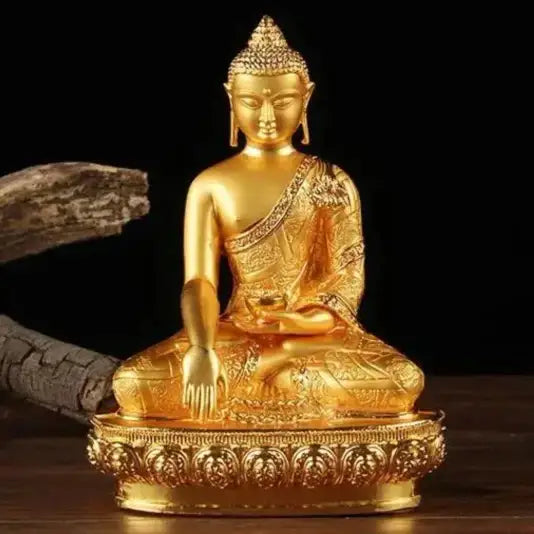
The allure of Buddha statues extends beyond their aesthetic appeal, often serving as potent symbols of good luck and spiritual enrichment. The fascination with these sculptures, especially in Western cultures, may stem from an intricate blend of religiosity and ornamental artistry. Positioned intricately in homes, temples, and gardens, these figures invite a broader inquiry into their symbolic resonance and the spiritual characteristics that bestow a sense of prosperity and well-being.
When discussing which Buddha statue embodies the essence of good fortune, one must delve into the nuanced interpretations of various depictions within Buddhist iconography. A prominent figure in this realm is the Laughing Buddha, also known as Budai or Hotei. This statue, distinct with its rotund belly and broad grin, is synonymous with happiness, abundance, and contentment. Many adherents believe that rubbing the belly of this effigy can yield fortune and attract positive energy, a testimony to its role as a benevolent harbinger of good luck.
Conversely, the statue known as the Meditating Buddha represents a different dimension of prosperity. Though ostensibly more austere than its cheerful counterpart, this representation holds profound significance. The act of meditation depicted in these statues signifies mental clarity and tranquility. This serene visage encourages individuals to seek inner peace as a pathway to external fortune. In many cultures, it is believed that fostering a serene mind equips one to attract wealth and success in different life endeavors.
Interestingly, the ‘Sitting Buddha’ figure symbolizes enlightenment gained through wisdom and introspection. This form embodies an understanding of life’s ephemeral nature, ultimately leading to a richer, more fulfilling existence. Observers often ponder how wisdom fosters a strategic outlook, allowing personalities to navigate life’s intricate tapestry with increased ease and success. What may superficially appear as mere aesthetic charm is, in deeper analyses, a call for thoughtful engagement with life’s opportunities and challenges.
Furthermore, the ‘Bhumisparsha Mudra’—a hand gesture wherein the right hand touches the earth—is particularly illuminating in its connotation. This gesture signifies a profound realization of enlightenment and the grounding of spiritual wisdom in the material world. Statues depicting this mudra are often venerated for their ability to assert one’s presence in the world, symbolically reinforcing notions of stability, strength, and bountiful luck, as they remind the faithful of their connection to both earthly and celestial realms.
There is also the aspect of geographical connotations associated with the locations from which various Buddha statues originate. Statues from different regions often incorporate unique symbolic elements. For example, the Tibetan Buddha statues are characterized by intricate ornamentation, often embellished with symbols of prosperity and protection. These symbols collectively signify the convergence of spiritual wealth and material success. Such regional variations enrich the tapestry of meanings attributed to Buddha statues and serve to illuminate the cultural dimensions of their spiritual symbolism.
As one contemplates the physical placement of Buddha statues in personal spaces, it becomes apparent that location plays an integral role in their purported efficacy. For instance, a statue placed in the home’s entryway is traditionally believed to usher in fortune and facilitate auspicious beginnings. This placement reflects a broader belief in the importance of intention and environmental energy in shaping one’s destiny. Synchronizing the physical presence of these statues with the astrological and environmental elements of one’s life amplifies their auspiciousness.
Considering the emotional context within which these statues are placed is also crucial. The contemplative act of meditating before a Buddha statue allows individuals to forge a connection with the spiritual significance inherent in the sculpture. This interaction serves as a catalyst for cultivating a mindset conducive to good fortune, as one imbues their daily routine with reflections on abundance and mindful intent. The ritualistic nature of these engagements reinforces the belief that one’s attitude and perspective are indeed vital components in the quest for luck.
In examining the interconnectedness of these varied representations, it becomes evident that the Buddha statues transcend singular definitions. Rather than merely being rapturous relics, they serve as pragmatic conduits for philosophical reflection and spiritual engagement. These figures beckon individuals to delve deeper into the essence of good luck, which is as much about external manifestations—wealth, success, and prosperity—as it is about nurturing an internal landscape characterized by peace, wisdom, and understanding.
Ultimately, engaging with Buddha statues provides a multi-faceted approach to grasping the complexities surrounding luck and spirituality. The amalgamation of cheerful representation, solemn meditation, and mindful placement synergistically cultivates an environment imbued with auspicious energy. By exploring these dimensions, seekers cultivate a profound awareness of the spiritual richness that arises from connecting deeply with these enduring symbols. The practice illuminates a pathway toward navigating life with gratitude, introspection, and deliberate intention—all essential ingredients for manifesting a life steeped in good fortune.
